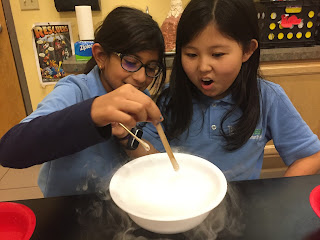In science experiment club this week the students explored with dry ice. They learned about the proper safety procedures when working with this material and the temperature of dry ice.
Older students discussed the phases of CO2 vs the phases of H20 and how temperature and pressure effect the substances in different ways.
Students were able to investigate what happens to dry ice when water is added, and when soapy water is added. Bubbly potions and students equals a ton of fun!
Wednesday, January 25, 2017
Wednesday, January 11, 2017
Integrating fairy tales with a STEM activity in Kindegarten
Mrs. Kilpatrick's class participated in a Project Lead The Way course about Structures and Functions and Exploring Design.
Students used the engineering design process to create models of Jack's beanstalk.
Their objective was to build the tallest beanstalk possible using pipe cleaners.
Student documented plans and evaluated their structures in their launch logs (engineering notebooks).
Make it Rain!
Mrs. Collins' 2nd grade class explored how clouds for from water in the air, and when they become too saturated with water droplets rain will begin to fall.
Students collected data on how many food coloring droplets their cloud needed before it began to rain in their "world."
Next, students researched different way to collect and analyze precipitation.
They created rain gauges, and then collected data ranging over one week.
During this time they tracked daily temperatures (highs/lows), precipitation, sunrise time, sunset time, and what the daily weather appeared to be (rainy, snowy, windy, sunny, cloudy, etc).
The discussions that came from these activities continued for days!
Friday, January 6, 2017
Anybody Need an Electrical Engineer?
6th grade students in Mrs. Isaacs' and Mr. Sonmez's classes have been designing parallel and series circuits while exploring voltage and magnetism.
The Series and Parallel Circuits activity encouraged students to test different circuit designs through the use of low voltage light bulbs and electromagnetism. Students worked in teams in oder to predict the difference between the two circuit designs, and then they built examples of the two different circuits using wires, bulbs, nails and batteries.
The Series and Parallel Circuits activity encouraged students to test different circuit designs through the use of low voltage light bulbs and electromagnetism. Students worked in teams in oder to predict the difference between the two circuit designs, and then they built examples of the two different circuits using wires, bulbs, nails and batteries.
Subscribe to:
Posts (Atom)










































